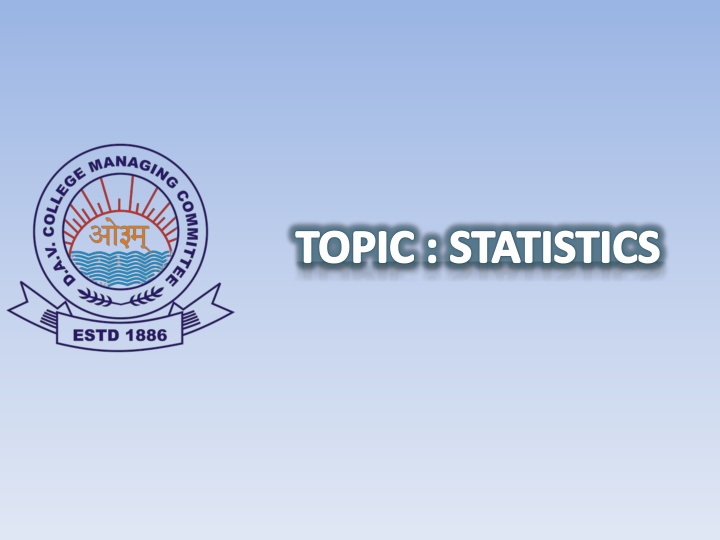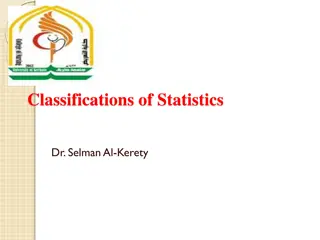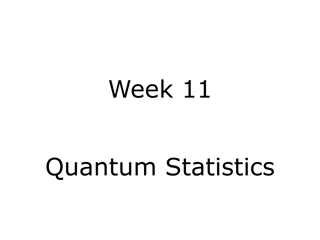
Statistics: Measures of Dispersion in Data Analysis
Explore the importance of statistics in analyzing data, focusing on measures of dispersion like range and mean deviation. Learn about the limitations of mean deviation and the variability in data interpretation.
Download Presentation

Please find below an Image/Link to download the presentation.
The content on the website is provided AS IS for your information and personal use only. It may not be sold, licensed, or shared on other websites without obtaining consent from the author. If you encounter any issues during the download, it is possible that the publisher has removed the file from their server.
You are allowed to download the files provided on this website for personal or commercial use, subject to the condition that they are used lawfully. All files are the property of their respective owners.
The content on the website is provided AS IS for your information and personal use only. It may not be sold, licensed, or shared on other websites without obtaining consent from the author.
E N D
Presentation Transcript
STATISTICS Statistics Statistics may and and their their estimates estimates. . may be be rightly rightly called called the the science science of of average average - -A A. .L L Bowley Bowley - -A A. .L L Boddington Boddington
LEARNING OBJECTIVE Measures of Dispersion The The dispersion dispersion or or scatter basis basis of of the the observations observations and central central tendency, tendency, used measures measures of of dispersion dispersion: : (i) (i) Range Range, , (ii) (ii) Quartile Quartile d viation d viation (Not (iii) (iii) Mean Mean d viation, d viation, (iv) (iv) Standard Standard d viations d viations. . scatter in in a a data and the used there data is is measured measured on the types types of of the there. . There There are on the the the measure measure of of are following following (Not in in syllabus) syllabus)
RANGE The difference of maximum and minimum values of each series. This difference is called the Range of the data. FOR EXAMPLE Consider now the runs scored by two batsmen in their last ten matches as follows: Batsman A : 30, 91, 0, 64, 42, 80, 30, 5, 117, 71 Batsman B : 53, 46, 48, 50, 53, 53, 58, 60, 57, 52 In case of batsman A, Range = 117 0 = 117 and for batsman B, Range = 60 46 = 14.Clearly, Range of A > Range of B. Therefore, the scores are scattered or dispersed in case of A while for B these are close to each other. Thus, Range of a series = Maximum value Minimum value.
LIMITATIONS OF MEAN DEVIATION If The Data Is More Scattered Or The Degree Of Variability Is Very High The Median Is Not A Valid Representative. Thus, The Mean Deviation About The Median Is Not Dependable. The Sum Of The Deviations From The Mean Is More Than The Sum The Deviations From The Median. The Mean Deviations Is Calculated On The Basis Of Absolute Value Of The Deviations. Some Times It Gives Unsatisfactory Result.
Variance and Standard Deviation while calculating mean deviation about mean or median, the absolute values of the deviations were taken. The absolute values were taken to give meaning to the mean deviation, otherwise the deviations may cancel among themselves. Another way to overcome this difficulty which arose due to the signs of deviations, is to take squares of all the deviations. Obviously all these squares of deviations are non-negative. Let x1, x2, x3, , xn be n observations and be their mean. Then
there is a lower degree of dispersion If this sum is large, there is a higher degree of dispersion of the observations from the mean.
Let us take the set A of six observations 5, 15, 25, 35, 45, 55. The mean ( ) of the following observations is=30. The sum of squares of deviations from for this set is = (5 30)2 + (15 30)2 + (25 30)2 + (35 30)2 + (45 30)2 +(55 30)2 = 625 + 225 + 25 + 25 + 225 + 625 = 1750 Let us take the set A of six observations 5, 15, 25, 35, 45, 55. The mean of the
Let us now take another set B of 31 observations 15, 16, 17, 18, 19, 20, 21, 22, 23,24, 25, 26, 27, 28, 29, 30, 31, 32, 33, 34, 35, 36, 37, 38, 39, 40, 41, 42, 43, 44, 45. The mean of these observations is =30 Note that both the sets A and B of observations have a mean of 30. Now, the sum of squares of deviations of observations for set B from the mean is given by = (15 30)2 +(16 30)2 + (17 30)2 + ...+ (44 30)2 +(45 30)2 = ( 15)2 +( 14)2 + ...+ ( 1)2 + 02 + 12 + 22 + 32 + ...+ 142 + 152 = 2 [152 + 142 + ... + 12] = 2 15 (15+1) (30+1) 6 = 5 16 31 = 2480
The observations in set A are more scattered from the mean (The range of deviations being from 25 To 25). Than in the set B (Where the range of deviations is from 15 To 15). This is also clear from the following diagrams. For the set A, We have For the set B, we have Thus, we can say that the sum of squares of deviations from the mean is not a proper measure of dispersion. To overcome this difficulty we take the mean of the squares of the deviations,
In case of the set A, we have Mean 1/61750 = 291.67 and in case of the set B, it is 1/31 2480 = 80.This indicates that the scatter or dispersion is more in set A than the scatter or dispersion in set B Thus, we can take as a quantity which leads to a proper measure of dispersion. This number, i.e., mean of the squares of the deviations from mean is called the variance and is denoted by 2
STANDARD DEVIATION Positive square-root of the variance is called standard deviation.The Standard Deviation, Usually Denoted By , Is Given By
SIMPLIFIED FORMULA FOR STANDARD DEVIATION
Example Find the variance & standard deviation of the following data: 6, 8, 10, 12, 14, 16, 18, 20, 22, 24 Solution From the given data we can form the following Table 15.7. The mean is calculated by step-deviation method taking 14 as assumed mean. The number of observations is n = 10
Example Calculate the mean, variance and standard deviation for the following distribution . Solution From the given data, the following Table was constructed
APPLICATION OF STANDARD DEVIATION Think of two amusement park rides. The wild roller coaster that goes up a giant hill, plunges down and goes upside down would have a high standard deviation. By contrast, the kiddie ride that goes on a mostly straight and level ride would have a low standard deviation
The same principle applies to stocks. A stock that tends to go up and down frequently, in large moves, would have a high standard deviation. A volatile stock is riskier because there's a greater chance of the investor facing a large loss at any given time especially a time when the investor might need to sell the stock.
HOMEWORK Find the mean and variance for each of the data 1. 6, 7, 10, 12, 13, 4, 8, 12 2. First n natural numbers 3. First 10 multiples of 3 4. 5.
6) Five Students Secured Marks As Follows 8,10,15,20,22.Find the Standard Deviation. 7) The Mean And Variance Of 8 Observations Are 9 And 9.25,respectively.If Six Of The Observations Are 6,7,10,12and 13,find Remaining Two Observations 8) Find The Standard Deviation Of The Set Of Numbers In The Arithmetic Progression 4,10,16,22, .,154 9) The Variance Of 15 Observations Is 5.If Each Observation Is Multiplied By 2,find The New Variance Of The Resulting Observation 10) For a group of 200 candidates the mean and S.D were found to be 40 and 15 respectively. Later on it was found that score 43 was misread as 34.Find the correct mean and correct standard deviation
STATISTICS- AT A GLANCE STATISTICS Measure of Central Tendency Measures of Dispersion Mode Mean Median Mean Deviation (M.D) Standard Deviation ( ) Quartile Deviation Range Q Q 1 n 1 n 3 1 = i = ( ) MD x x x Max Value Min Value = i ( ) Variance x x 2 i n 1 1 n 1 n = i = 2 ( ) = i f x x = ( ) MD M x x i i N 1 i n 1 1 n = i = 2 ( ) x x i n 1 1 n = i 2 = 2 ( ) N f x f x i i i i N 1 n n n = i = i 2 = 2 ( ) N f y f y i i i i N 1 1






















